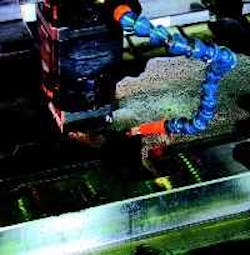TCO Delivers TKO In EDM Productivity
Total-cost-of-ownership analysis proves electrode material matters.
Electrode material affects EDM productivity more than most shops believe.
Using benchmark data from equipment and graphite vendors, shops conduct TCO audits of their EDM processes to identify areas of potential savings by comparing actual costs against accepted benchmarks.
For one Poco customer making speaker molds, a TCO analysis showed that switching to a high-quality EDM-electrode graphite saved time and money for the job.
Moldmaking shops constantly fight to keep production costs competitive, and one of their best strategies is incorporating new equipment and technologies. When they do so, these shops often assess the costs of owning and operating the new equipment/technology using a total-cost-of-ownership (TCO) analysis. When applied to sinker EDMs, this analysis/audit indicates that one of the most critical aspects of operating sinker EDMs is that an electrode material's performance greatly affects machine productivity.
Using benchmark data from equipment and graphite vendors, shops conduct a TCO audit of their EDM processes and identify areas of potential savings by comparing actual costs against accepted benchmarks. The audit usually shows that shops can gain additional capacity from existing equipment and reduce EDM machining hours to increase productivity.
EDM-equipment manufacturers publish charts of typical metal-removal rates and percentages of electrode wear for specific machine settings and workpiece and electrode materials when EDMing at optimum conditions. Shops then use these same parameters to measure actual metal-removal rates and percent of electrode wear to compare how close to the benchmark their machine is performing.
Moldmaking shops constantly fight to keep production costs competitive, and one of their best strategies is incorporating new equipment and technologies. When they do so, these shops often assess the costs of owning and operating the new equipment/technology using a total-cost-of-ownership (TCO) analysis. When applied to sinker EDMs, this analysis/audit indicates that one of the most critical aspects of operating sinker EDMs is that an electrode material's performance greatly affects machine productivity.
Using benchmark data from equipment and graphite vendors, shops conduct a TCO audit of their EDM processes and identify areas of potential savings by comparing actual costs against accepted benchmarks. The audit usually shows that shops can gain additional capacity from existing equipment and reduce EDM machining hours to increase productivity.
EDM-equipment manufacturers publish charts of typical metal-removal rates and percentages of electrode wear for specific machine settings and workpiece and electrode materials when EDMing at optimum conditions. Shops then use these same parameters to measure actual metal-removal rates and percent of electrode wear to compare how close to the benchmark their machine is performing.
An EDM operation not achieving benchmark numbers means slower production than competitive shops. It also indicates that machines aren't running at full capacity. Fortunately, reaching these benchmark settings is usually as easy as switching to a high-performance graphite, according to Poco Graphite in Decatur, Tex.
Not using the best graphite material reduces productivity in several ways. These include unstable cutting that extends burn time, inability to efficiently produce desired surface finishes, and scrapped parts due to out-of-spec tolerances or surface pitting. "Purchasing new equipment may improve these problems," says Sam Allison, general manager at Poco Graphite, "but using the best graphite for the job is really the solution."
Electrode-material quality also affects other shop operations or cost centers, such as electrode fabrication and mold-polishing cells. Graphite with high hardness increases the number of required cutters or special tooling to fabricate electrodes. Graphite that wears too quickly means using additional electrodes or redressing electrodes, which shortens their life and increases job costs. Graphite that produces poor-quality surface finishes means more polishing to finish a cavity, which also increases job costs.
"High-performance graphite electrode materials decrease electrode fabrication time, burn time, and polishing. Shops looking only at the cost per cubic inch of graphite, rather than the total production costs associated with the job, may actually lose money by not purchasing the best graphite material," says Allison.
Like EDM-equipment manufacturers, graphite manufacturers also supply models and benchmarking data for shops to compare various grades of graphite through TCO analysis. Shops should select graphite grades based on the material's ability to achieve specific surface finishes, reproduce critical details, and metal-removal rates.
TCO in action
Through TCO analysis, many of Poco's customers improve their EDM production. For one such customer producing speaker molds, the analysis indicated that switching to a high-grade Poco graphite material would shorten the shop's electrode-fabrication process.
Electrode fabrication was a long process because the shop used both graphite and copper to obtain desired results. Because of the graphite's hardness, the shop had to make small cuts when milling the electrode. Fabricating one graphite electrode required three milling passes: rough, semifinish, and finish. To make matters worse, cutters wore out after each milling pass, and after completing the graphite electrode, the shop had to produce a copper one.
Instead of the graphite-copper combination, a Poco applications specialist recommended two grades of high-performance graphite, a 10-µ material for roughing and a 5-µ type for finishing, so the job could be completed entirely in graphite.
The shop now uses one cutter to fabricate both graphite electrodes and machines each electrode in a single pass to significantly reduce milling and cutter costs. The two new grades also increased EDMing speed.
The customer then input actual milling and EDM times, along with other shop information, into the TCO model. This showed the EDM manager the percentage of improvement for the job, the dollar savings, and the increased capacity gained in both the milling and EDM operations by upgrading to a high-quality graphite material.
